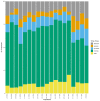A mixed methods analysis of participation in a social contact survey
- PMID: 36182804
- PMCID: PMC7615368
- DOI: 10.1016/j.epidem.2022.100635
A mixed methods analysis of participation in a social contact survey
Abstract
Background: Social contact survey data forms a core component of modern epidemic models: however, there has been little assessment of the potential biases in such data.
Methods: We conducted focus groups with university students who had (n = 13) and had never (n = 14) completed a social contact survey during the COVID-19 pandemic. Qualitative findings were explored quantitatively by analysing participation data.
Results: The opportunity to contribute to COVID-19 research, to be heard and feel useful were frequently reported motivators for participating in the contact survey. Reductions in survey engagement following lifting of COVID-19 restrictions may have occurred because the research was perceived to be less critical and/or because the participants were busier and had more contacts. Having a high number of contacts to report, uncertainty around how to report each contact, and concerns around confidentiality were identified as factors leading to inaccurate reporting. Focus groups participants thought that financial incentives or provision of study results would encourage participation.
Conclusions: Incentives could improve engagement with social contact surveys. Qualitative research can inform the format, timing, and wording of surveys to optimise completion and accuracy.
Keywords: Epidemic modelling; Focus groups; Infectious disease; Mixed methods; Research engagement; Social contact surveys.
Copyright © 2022 The Authors. Published by Elsevier B.V. All rights reserved.
Conflict of interest statement
Conflict of interest HC is a principal investigator on a grant funded by GlaxoSmithKline unrelated to this research. All other authors declare no competing interests.
Figures




References
-
- Hall CB, Douglas RG. Modes of transmission of respiratory syncytial virus. J Pediatr. 1981;99(1):100–103. - PubMed
Publication types
MeSH terms
Grants and funding
LinkOut - more resources
Full Text Sources
Medical

